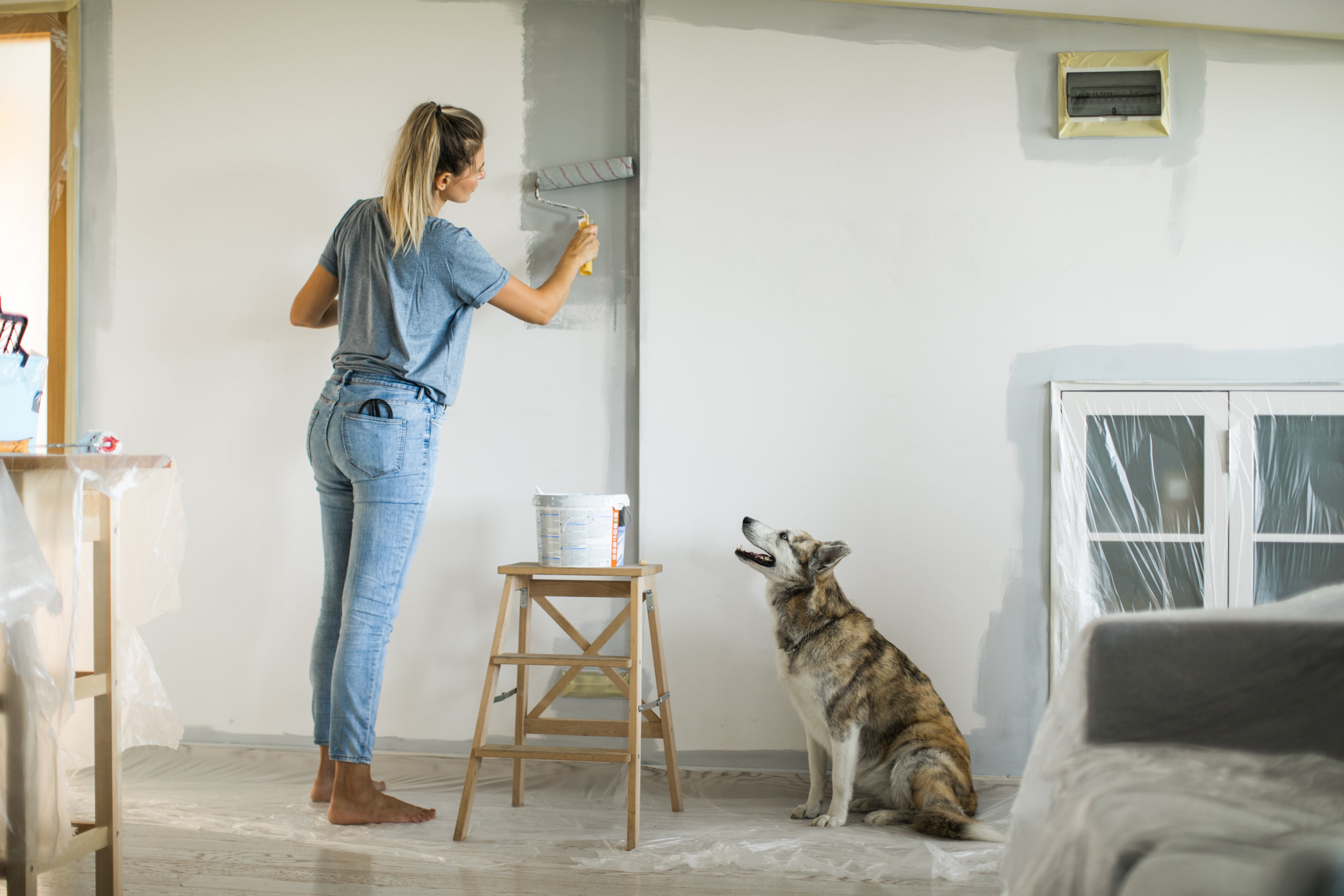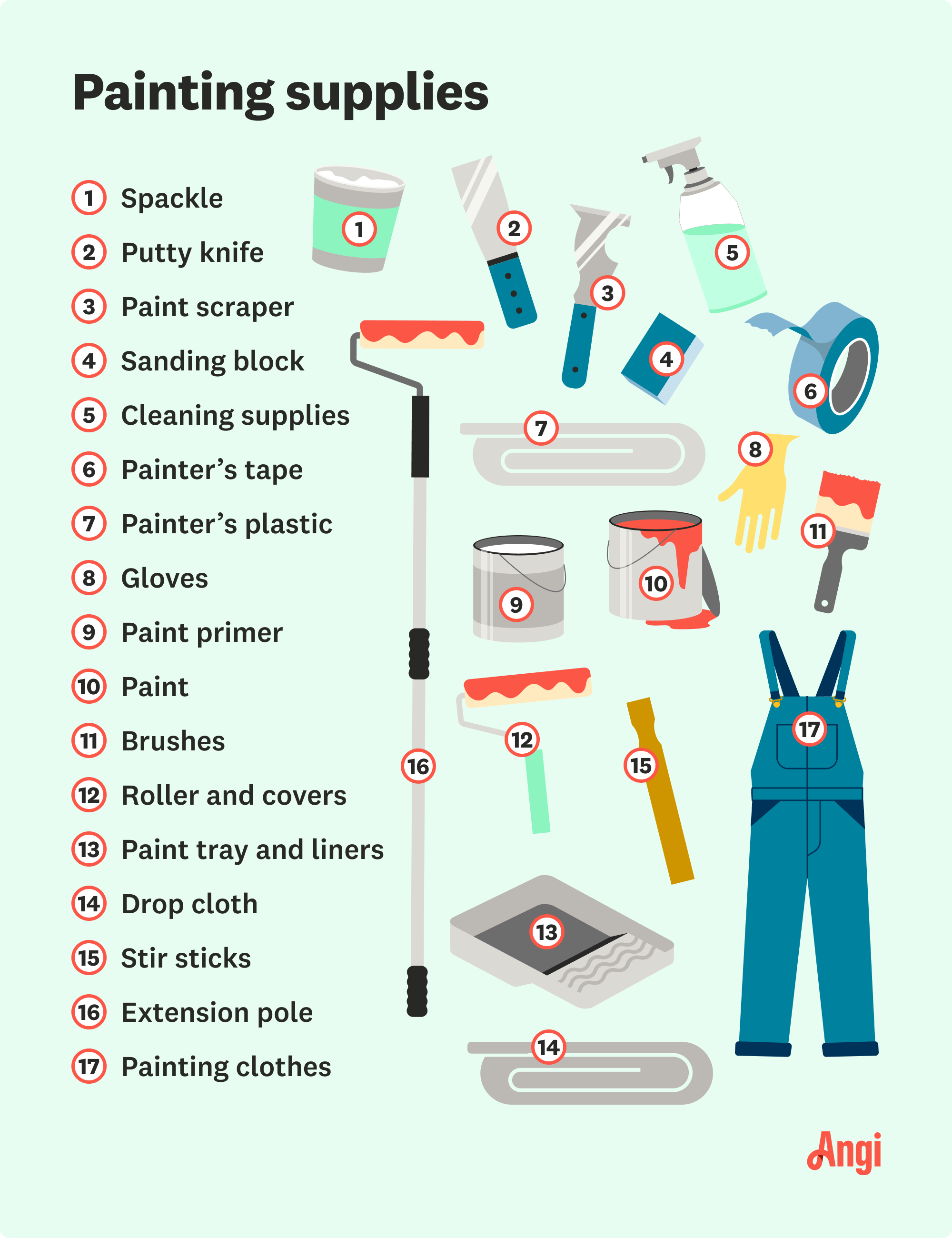
The cost to paint the interior of a house in Orlando, FL depends on size, layout, type of surface, and more. Learn what factors can influence your total in this guide.
Painting can be messy, but choosing between latex and acrylic doesn’t have to be


Latex paint is best for interior projects and comes in more finish options.
Latex paint is less expensive and more environmentally friendly.
Acrylic paint holds up better outdoors and in bathrooms.
Acrylic and latex paint both have a solid life span of five to 10 years.
Is it time for an exciting new painting project? Either acrylic or latex paint could be the perfect match for you, depending on what you’re painting. Latex is great for interior projects, such as walls and ceilings, while acrylic is better for exterior projects and bathrooms.
If you need help deciding between the two, we've got your back. Learn all about latex vs. acrylic paint to choose the right type of paint for your project and successfully reinvent your space.
Latex paint and acrylic paint are both water-based options, but have different price points and durability. Certain key factors make each paint best in certain situations. Here’s a look at the main differences between these two popular paint options.
Latex paint is less expensive and better for interior projects, while acrylic paint can be more durable and better for high-moisture applications like bathrooms.
Since both acrylic and latex paints use synthetic resins to suspend and bond pigments in a liquid medium until dry, the major difference between the two is the name of the resin.
Acrylic paint tends to be longer-wearing than latex, while latex tends to be simpler to apply.
Since both paint types are water-based, they’re popular for cleanup and safety reasons.
| Latex Paint | Acrylic Paint |
|---|---|
| Better for interior walls and ceilings | Best for exterior projects and bathrooms |
| More affordable | More expensive |
| Easier to apply | Adheres well |
| Lifespan of 5 to 10 years | Lifespan of 5 to 10 years |
| More environmentally friendly | More durable |

Latex paint is a water-based paint made of pigments, binders, and water-based liquids. It’s durable and non-toxic, making it great for interior projects. You can choose between a variety of sheens ranging from flat to high-gloss to best fit the home painting project you’re working on.
Latex paint is the more affordable option in most cases, making this a no-brainer for anyone painting over a large surface area or multiple rooms. Of all the paint types, latex releases the lowest amount of volatile organic compounds (VOCs), which makes it an environmentally friendly paint option and suitable for indoor use around pets and children.
Oil-based paints contain higher volatile organic compounds (VOCs) than latex paints. To limit your exposure to VOCs while painting indoors, keep the area well-ventilated, wear respiratory protection, and avoid the painted area for at least 72 hours once finished.
| Pros | Cons |
|---|---|
| Affordable | May cause wood grain to swell |
| Dries quickly with minimal odor | Can show brush strokes |
| Water-resistant surface that won’t yellow over time | Doesn’t adhere to some surfaces like metal |
Latex paint has a lot of benefits and is a popular choice for a variety of home painting projects. In addition to being an affordable option, it’s also easy to work with. It doesn’t take long to dry and covers most surfaces in just a few coats, so the painting process will be a breeze. Its low VOC content also means no harsh fumes while you’re painting.
Latex paint is water-resistant, so it’s easy to clean and ideal for high-traffic areas like hallways, staircases, kids’ rooms, and higher-humidity rooms like kitchens. It’s available in various finishes, from matte to glossy, and is unlikely to turn yellow over time.
The high water content in latex paint can be a drawback when painting wood surfaces—the wood grain may swell due to the added moisture. Depending on the finish and application method, latex paint can also show brush strokes, so you may need to take care to get an even finish. Latex paint also isn’t ideal for all surfaces—it won’t adhere well to some types of metal without thoroughly prepping the surface and using a specially designed primer.
Aluminum siding
Ceilings
Concrete
Drywall and plaster
Interior projects
Painting large areas
Stucco
Wood

Acrylic is a water-based paint made of pigments, binders, and acrylic resin. It expands and contracts well, making it great for outdoor projects, such as painting your wood siding. Acrylic paint is also mold-, mildew-, and water-resistant when dry, so many people choose acrylic when painting a bathroom. Flat, satin, and gloss are the most common finish options for acrylic paint, but sometimes you can find high-gloss or semi-gloss paint sheens in acrylic.
| Pros | Cons |
|---|---|
| Mold-, mildew-, UV-, and water-resistant | More expensive |
| Strong adhesive properties | Moderate VOC levels |
| Thick, durable coverage | May require multiple coats |
| Expands and contracts with fluctuating temperatures | Limited finish options |
Acrylic paint’s durability and resistance to mold, mildew, water, and UV rays are all benefits of choosing this type of paint, especially for exterior painting projects. Its thick, durable coverage and ability to expand and contract mean this paint won’t peel off the walls or crack when exposed to fluctuating temperatures.
Acrylic paint also offers superior adhesion to a variety of surfaces, so you can use it to paint wood, metal, vinyl siding, drywall, and more. Its finish options are also more limited, so it’s harder to find some glossier finishes.
All of acrylic paint’s advantages do come with a few drawbacks. It’s a pricier option than latex paint, so your project cost will be higher. It may also require more coats than latex paint for an even finish, so you’ll end up using more paint overall.
Acrylic paint has a moderate VOC content, which makes it more suitable for outdoor projects where there’s open-air ventilation rather than indoor projects.
Bathrooms
Cabinets
Exterior projects
Interior trim
Painting over rust
Siding
Small pieces of furniture

When you’re choosing between acrylic and latex paint, different factors may make one a clearer choice for your project over the other. Here's a breakdown of key factors you should consider when deciding on latex vs. acrylic paint, with a clear winner in each category:
Both latex and acrylic paints look beautiful and smooth on the proper surfaces. Acrylic paint holds up better outdoors thanks to its ability to expand and contract. It’s also UV-resistant, helping it to fend off any fading.
Latex paint, on the other hand, holds up well indoors and is easy to clean. It’s also a go-to paint choice for ceilings, high-traffic areas, and a variety of indoor painting projects. Latex beats out acrylic for appearance because it’s available in a wider variety of finishes and is easy to keep clean and looking new.
Acrylic paint is better for outdoor use because it expands and contracts with fluctuating temperatures. It also resists moisture and scuffs, making it the better choice for bathrooms and interior trim. Latex paint is durable enough for painting interior walls and ceilings, but it isn’t as adaptable as acrylic paint.
Latex paint is less expensive than acrylic due to its wide availability. A gallon of interior latex paint costs $15 to $60, while a gallon of exterior acrylic paint costs $20 to $80 on average.
It’s easier to apply latex paint than acrylic paint. It dries quickly, allowing you to paint another coat after four hours. While some acrylic paints only require four hours between coats, experts recommend waiting eight to 12 hours between coats to ensure the best result.
Latex paint is also a bit more forgiving than acrylic paint. While latex dries quickly, you can clean off mistakes and drips with a clean, damp cloth or paper towel. Acrylic adheres extremely well and is harder to remove if you make a mistake.
No matter which paint type you choose, after your paint is fully dry, you can clean your walls and other painted surfaces with warm water and a gentle cleaning agent. Both latex and acrylic paints are easy to touch up and maintain in the event that the kids get a little too overzealous with their crafts or someone takes a tumble while holding their dinner.
The life span of latex- and acrylic-painted surfaces is five to 10 years on average, depending on the quality of the paint and the wear and tear. Acrylic paint holds up better outdoors due to its UV resistance and ability to expand and contract with temperature changes. Latex holds up equally well indoors in non-humid spaces.
Latex paint emits low levels of VOCs, making it environmentally friendly and safe for indoor use with children and pets. Acrylic paint emits a moderate amount of VOCs, so take standard safety precautions if you’re using it indoors, such as wearing a protective mask and ensuring you properly ventilate the area.
By now, you probably have a better idea of who will come out on top for your project in the battle of latex versus acrylic paint. However, getting a second opinion is never a bad idea. For an expert’s viewpoint on the best type of paint for you, work with a local interior painter. They can help ensure the best finish, appearance, and longevity of your paint project.
From average costs to expert advice, get all the answers you need to get your job done.

The cost to paint the interior of a house in Orlando, FL depends on size, layout, type of surface, and more. Learn what factors can influence your total in this guide.

The cost to paint the interior of a house in Chicago, IL depends on size, layout, type of surface, and more. Learn what factors can influence your total in this guide.

The cost to paint the interior of a house in St. Louis, MO depends on size, layout, type of surface, and more. Learn what factors can influence your total in this guide.

Interior painting can make your home more appealing to buyers. Learn how much interior paint can increase your home’s value.

Waterproof paint is a quick and easy way to combat moisture in basement spaces. Learn why it may not be a permanent fix and what your best alternatives are.

You don't need a professional or an expensive tool to match your wall paint. Learn how to match paint color already on walls with this helpful guide.